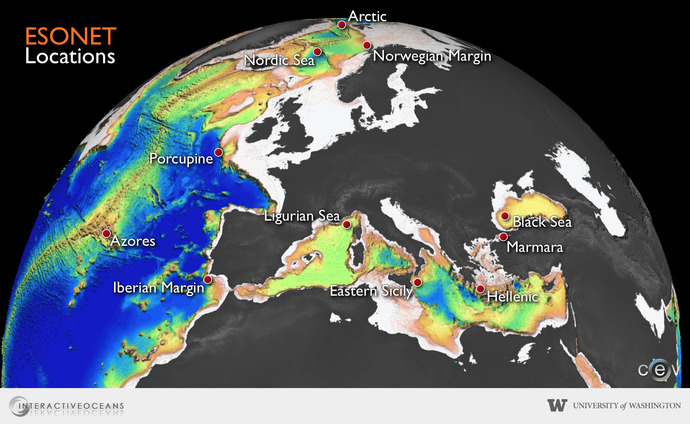European Multidisciplinary Seafloor Observation (EMSO) is the European large-scale infrastructure composed of seafloor observatories for long-term monitoring of environmental processes related to ecosystems, climate change, and geohazards. This infrastructure is included in the European Strategy Forum on Research Infrastructures (ESFRI) Roadmap. EMSO nodes are placed in specific marine sites on the European Continental Margin from the Arctic to the Black Sea through the Mediterranean Basin. These sites were selected within European Community projects in 2002-2004 and the ongoing European Seas Observatory Network of Excellence (ESONET-NoE).
The design and development of the nodes depend upon: geographical location, scientific requirements, operational requirements, and available resources. Two basic models can be envisaged for the nodes: 1) stand-alone acoustically-linked observatories, and 2) cabled observatories. However, hybrid configurations could be adopted according to site characteristics. The nodes will be equipped with a common set of sensors for basic measurements and further sensors for specific purposes.
EMSO will constitute the subsea segment of Global Monitoring for the Environment and Security (GMES) and Global Earth Observation System of Systems (GEOSS).
EMSO is presently in the Preparatory Phase (EMSO-PP) with a project of EC-FP7. This project will establish the legal entity EMSO which is able to manage the scientific, technical, logistic and administrative components of the infrastructure. EMSO-PP has started in April 2008 and will run for 4 years.
The inclusion of the EMSO infrastructure in the ESFRI list is based on the development of EC projects dating back to 1990 that aimed at realising and validating seafloor observatory and network prototypes. The establishment of a multidisciplinary network of seafloor observatories is currently supported by the EC through the ESONET-NoE (2007-2011) [1] which comprises more than 50 European universities, research institutes, companies involving 14 countries and about 300 scientist, engineers and technicians. This project aims at boosting the integration of the European Ocean Sciences community interested in observatories.
EMSO will allow scientists to understand:
• the environmental processes as interaction between the geo-, bio-, and hydro-sphere;
• the temporal evolution (short-, medium- and long-term, periodic and episodic events) of the oceanic circulation, earth processes, deep-sea environment and ecosystems.
EMSO will take advantage of the synergies between the scientific community and the industry and will contribute to a significant improvement of marine technologies and the development of strategies for improving European capacities and competitiveness in ocean sciences and technologies.
The rationale for EMSO infrastructure is based on the following issues:
• Scientific: the sea as key element to understand the dynamics and evolution of the Earth components;
• Technological: maturity of methodology and approaches for deep-sea observations (i.e., long-term time series);
• Strategic: environmental control for preservation (habitat, biodiversity), mitigation of hazards, new resources exploitation;
• Cultural: strengthening the European Research Area (ERA).
[1] P. Favali, L. Beranzoli, EMSO: European Multidisciplinary Seafloor Observatory, Nuclear Instruments and Methods in Physics Research Section A, 602, 21-27, doi:10.1016/j.nima.2008.12.214, 2009.





